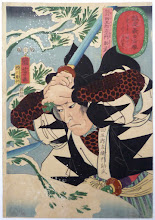Reading bits and pieces of the Rules Compendium in my spare time (I have a hard time abbreviating it as RC, as to me that's the 1991 Rules Cyclopedia for Classic D&D so I'll call it the 4RC from now on). I blogged about it earlier, here.
I finally got through Chapter 2: Adventurers and Monsters. Here are some thoughts about it.
Monsters do not need the same sorts of stats as PCs. This was a mistake that 3E made (although it seemed like a novel feature in 2000, it didn't really work so well). However, monsters are basically only designed for combat, nothing else.
Monster types from 3E have been retained, but further streamlined, although they're broken down into 'origin' and 'type' which can be combined. This could be useful, as some 3E monsters didn't fit well into only one type (or would 'lose' a type when a certain template was added, or whatever). Initial impression looks to be a simplification of the 3E way, and that's always a good thing.
Monsters also get a 'role' that they play in battle. Maybe the Monster books give more than what I've heard they do, but it looks like there aren't many things for the creatures to do outside of battle. The rules keep talking about all the non-combat stuff you can do, but then these not so subtle design choices scream "This is just one big combat game!"
Ability score bonuses work just like in 3E. They modify slightly different things, but more or less match what earlier editions had done. Later in the chapter, talking about generating ability scores, though, I just had to laugh. They give 3 options: Take the default array, point buy, or roll randomly 4d6-L. But then it says DMs should modify any random rolls back into the proper range. [Message between the lines--your DM is a douche if he makes you do this because chances are your character will suck, and if you get lucky and roll well, he'll smack you down to normal levels so just use the default array already.]
The sample scripts suck. Take a look at Spanish. It has extra letters beyond the 26 in English. Cyrillic, Greek, and other alphabetical languages don't have the exact same letters as English. Runic languages have a lot fewer letters. Yes, I'm a bit of a language geek, so this bothers me that the sample scripts are just different symbols for the English alphabet. What, are we supposed to use them to pass notes in class that the teacher can't read?
Alignments. Why did it have to be snakes... I mean alignments? OK, this is a hot button topic in any edition. But the LG-G-U-C-CE breakdown seems a bit weird. The descriptions of Good and Evil read more or less like the classic depictions of Chaotic Good and Lawful Evil, but the naming conventions made me think they would follow the Neutral Good and Neutral Evil ideas more. They didn't. Oh well, if they had, then it might have been more like sticking 'super-Lawful' and 'super-Chaotic' alignments onto the Classic Law-Neutrality-Chaos system.
Next we get a general rundown of character creation. I already mentioned the ability score generation. The rest is fairly boring, pick your feats, pick your powers, fill in the numbers, blah blah blah.
Then we get to the 'Other Character Details' part. Gets a bit interesting here. First a relatively useless side bar on p. 81 about adding minor details to your character to make them distinct. Nobody's really gonna remember that you've got a birthmark like a pixie on your left cheek or that you wear outrageous clothing unless you're always mentioning it at the table the way Robert Jordan always uses his stock phrases to describe minor characters ("he rode his saddle like sack of suet"...how many times do I need to read this about the fat horse thief guy?). Note to those playing at home--don't do this, it'll get annoying.
The rest of the advice for adding personality to your PC, on pages 81-84 aren't bad, though. Some decent advice, especially in telling the reader that it's okay to not have a fully fleshed out 3-page background for your 1st level PC. As Gary once said (or at least someone quoted him as saying this on the internet), "The first five levels are your back story."
Finally, we round out the chapter with some notes on how to level up your character. Characters tend to get feats on even levels (and increases in their 1/2 level bonus), while Powers are usually gained at odd levels. So you get something at almost every level. For this type of game, I guess that's important.
The only other real observation I had was that leveling up in this version of the game loses quite a bit of excitement. You're encouraged to be 'planning ahead' to what powers and feats you'd like, so there's more of a sense of accomplishment than a sense of gaining something new and different. Also, characters gain set numbers of hit points per level, so you lose that excitement of rolling the dice when you level. Sure, it sucks to roll a 1 on that hit point roll, but isn't it great to roll the max number for your class? I think I'd miss that thrill if I were to play a long campaign under 4E.
Still, while I've got my criticisms of the game, there's less to hate than I expected, and some useful sections as well. Next chapter is Powers.
Friday Fantasy: Return of the Green Death
5 hours ago






The habit of treating 'Lawful Good' and 'Chaotic Evil' as 'very good' and 'very evil' isn't original to 4th edition in my opinion. For example Paladins have to be Lawful Good rather than Neutral Good.
ReplyDelete